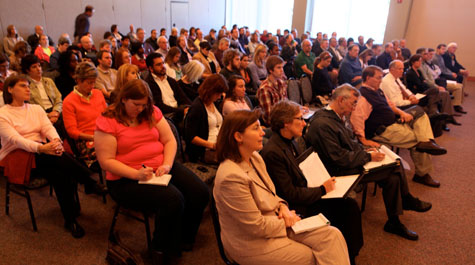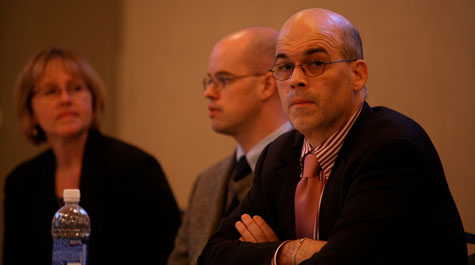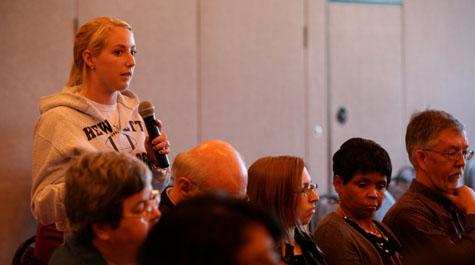W&M community considers impacts of growth
Should William & Mary consider it? And if the College’s student body does grow – even modestly -- what are the impacts to academics, students life, admissions, finances and the local community?
That was the focus of a campus forum Thursday hosted by a campus-wide committee charged with the task of evaluating the impacts on and off campus if William & Mary grew its size. The committee, made up of faculty, staff and students, was appointed last spring by President Taylor Reveley and is co-chaired by Provost Michael R. Halleran and Associate Professor of Business Todd Mooradian.
“No decision is imminent. What we are looking at is if we are going to grow – and notice the word ‘if’ – let’s think carefully about it,” Halleran said in welcoming a packed audience in the Tidewater A room of the Sadler Center. “If we are going to grow let’s do it intentionally and let’s do it strategically.”
The co-chairs added that the committee’s charge is not to make a recommendation on growth -- only to provide the president with information on the impacts if William & Mary’s entering class grew even modestly, such as adding 50 students to a freshmen class that now is about 1,400 students.
“We are not making a decision or even a recommendation,” said Mooradian, adding there are no plans to emulate growth at other state schools. Scale is an important piece of the discussion.
“The majority of our energy has been devoted to finding out what the impact would be,” he said. “And to do this in the William & Mary way … thinking through ideas in a thoughtful way.”
Part of that process is to look at the impact to academic experience, most notably the need for additional resources. Berhanu Abegaz, professor of economics and director of the Africana Studies program, said Arts & Sciences has absorbed additional students over the past several years while also absorbing significant cuts due to the state’s budget crisis. If the College was going to grow, he added, it would require more resources for additional labs, freshman seminars and faculty.
Henry Broaddus, dean of admission, said the adding 50 students to the entering class would not impact the quality of the entering class. The College received 12,500 applications last year for 1,400 spots.
“We are turning down a lot of students who are exceptional,” said Broaddus, who added growth would impact the admit rate and yield of the entering class. For that reason, it would be important to sustain and invest in the College’s outreach to prospective students, he said.
Ginger Ambler, vice president for student affairs, said the biggest impact to student life would be housing and parking. Currently, the College has students each year who are on the wait list for space in the dorms. The College’s strategic plan calls for adding 250 beds on campus -- and the opening of Tribe Square next fall will bring 56 beds – but any growth will impact space on campus, she said.
“We are very much aware that the residential experience is valued by our students,” said Ambler. Officials added that the College would also need to consider and be cognizant of the impact to the local community, especially city residents who live nearby campus.
Perhaps the most anticipated question focused on the finances of growth. Sam Jones, vice president for finance, explained that said the impact of additional money would be minimal. Another 50 students to the freshman class would eventually bring about $800,000 in additional revenue. But at least a quarter of that would need to go to increasing need-based financial aid and another significant amount would be needed for additional instructors. Add in other costs and, depending on the level of investment for instruction, the net gain could be as low as $200,000, Jones said.
“This is really not a budget balancing exercise,” he said.
Any growth, members of the committee agreed, would be driven fundamentally by the political realities in Richmond. There is increasing pressure, Mooradian said, for the state’s highly selective public universities to take more Virginia students. Last year, for example, there were a number of proposals before the General Assembly that looked at increasing the percentage of in-state students at state universities. Like other schools, William & Mary’s budget depends greatly on the income from the out-of-state students who make up 35 percent of its undergraduates. While those bills were not successful, the discussion in Richmond has moved from increasing the percentage to increasing the total number of Virginians who attend public universities. A commission was appointed earlier this year by Gov. Bob McDonnell to look at higher education. Growth is key part of that discussion.
“We have been able to shift the discussion,” said Fran Bradford, associate vice president for government relations. “But they do expect us to have a real conversation and that is what we are doing.”
A part of that conversation – and a part of the advocacy work across the state – will include the fact that the state’s public universities bring residents a diversity of options. The state system, officials said, can not be approached with a “one size fits all” model. Any growth would need to consider each institution’s unique characteristics.
“I think everybody recognizes William & Mary is a special place,” Halleran said. “A big part of that is our size so we want to be very mindful of that.”
Those in attendance asked that part of that conversation include looking at ways William & Mary could grow without impacting the physical campus. For example, investing to expand study-abroad programs could be an option. Satellite campuses could be another. Others asked that any growth wait until new dorms and new courses were already in place.
A student asked that the committee consider impacts to efforts in sustainability. Joanne Braxton, the Cummings Professor of English and the Humanities, asked the audience to consider how growth will impact the College’s sense of community.
“Growth, like migration, has its costs,” she said. “I would want to underscore the issues of human sustainability. We need more opportunities for human interaction.”
 Skip to main content
Skip to main content



